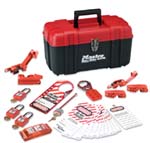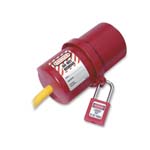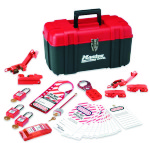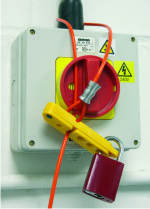Lockout Tagout Procedure
Lockout Tagout is a planned safety procedure that disables the energy supply of industrial machinery and equipment whilst servicing, maintenance work or repairs are in progress. The aim of this system is to effectively protect workers from the dangers created by live machinery or electricity, therefore lowering the overall level of risk when working with this equipment. The standard procedure for implementing Lockout Tagout is laid out below. All steps should be carried out either by a single authorised employee or the employer, and company regulations must be followed at all times when implementing the Lockout Tagout procedure.
Step 1: Preparation Prepare for a shut down of energy source. Identify the type of energy used (e.g. electrical) and the potential risks, considering the type and magnitude of the energy and how it can be controlled.
Step 2: Notification Locate the isolator(s) and prepare to ‘lock off’ energy source.
Step 3: Shut-down Turn off the equipment or machine, following established procedures and ensuring that there are no increased hazards from equipment stoppage. Isolate equipment from energy sources, by disconnecting switches, circuit breakers, valves etc.
Step 4: Lock Off Lock off all energy sources in the safe/off position, at each isolating device, using the proper lockout devices. Apply a lock so no one can turn the switch or valve whilst the work is in progress. Warn against accidental use by attaching lockout warning tags. If several employees are working on the same equipment, make sure each puts in place their own identification label and own safety padlock.
Step 5: Test Check all of the machine controls and electrical circuits to ensure energy is completely isolated. (Release stored energy, verify machine in ‘zero energy state’- operate controls to verify isolated before returning to ‘off’ position. Could include reading pressure/temperature gauges, using test equipment)
Step 6: Repair or rework Perform maintenance/servicing/repairs.
Step 7: Return to service When the work is completed take off the lockout/tagout devices and proceed to test, ensuring that all tools and mechanical and electrical lockout devices have been removed. Lockout devices must be only be removed by the person who applied them- if several employees are working on the same piece of equipment, the team supervisor must remove their lockout device last. Warn all workers before re-energising, check the work area to ensure all employees are at a safe distance from the equipment, and restore the energy supply to the machine. |
Thank you for viewing our Lockout Tagout procedure page. Below are a few products which can help you with Lockout Tagout. Or, visit our website: |
|
Zenex padlocks have a wide variety of products and come in varying sizes and colours, and have a range of keying options:
View our full range HERE. |
|
| When working in this dangerous industry, it is crucial to take enforcement action to ensure health and safety. Providing workers with fit for purpose, custom mechanical lockout kits along with robust procedures keeps your workers safe. Choose from our universal Lockout Kit range and ensure safe workplaces. Everyone should be able to go to work and return home safe and unharmed through effective safety policies Lockout Tagout Program underpinned with the right lockout devices/tools. choose the right kit or call us for a custom kit. These portable kits provide all the equipment required for implenting lockout tagout procedures. Available in personal and team sizes. View our full range HERE. |
|
| Cable lockouts are a great basic tool for securing valve handles or for connecting multiple locked-out valves. See our full range HERE. | |
Importance of Lockout Tagout (from the HSE website)
 |
 |

























